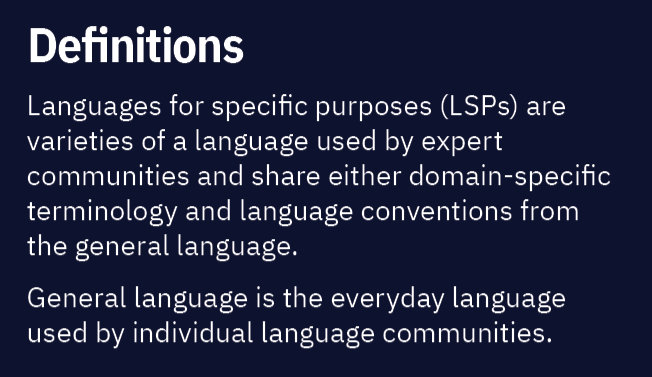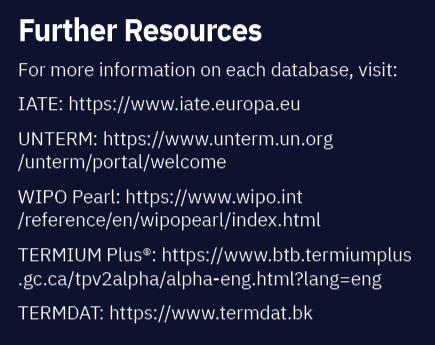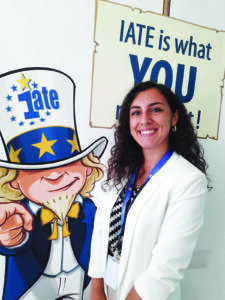By Maria Carmen Staiano
Terminology resources provide translators with the information needed to learn the subject matter and improve the overall clarity for readers.
Terminology is a discipline unto itself, and one that plays a particularly important role in technical communication for intergovernmental organizations (IGOs). It maintains linguistic consistency, ensuring that the same message is communicated in different countries.
What Is Terminology?
Terminology is a discipline that studies the relationships between concepts and terms, which are relevant to one or more specialized domains of human activity.
Terminology as a science mainly deals with:
- the standardization of the use of terms
- the transfer of knowledge within and across specialized communication settings
- the systematic description of terms belonging to specific subject fields
- the creation of useful resources for translators, technical writers, buyers and language service providers
Why Terminology Planning Matters
Having standardized terminology has stepped up as an essential factor in every organization. Terminology departments are becoming an asset in their standardization and harmonization activities.
Terminology planning activities deal with the organization of terms. This ranges from the creation of neologisms to the standardization of existing ones and to term representation by responding to the target user needs and demands of domain communication.
In this context, terminology planning matters because it helps to organize technical communication, setting boundaries between languages for specific purposes (LSPs) and the general language. It explains why terms sometimes converge into each other since language contact, borrowing, and code-switching are widespread phenomena in technical communication.
 Terminology resources provide translators with the information they need to resolve doubts (i.e., find an equivalent in the target language), learn the meaning of a term in the source language, or select the best option between different terms. However, it should be added that terminology ensures that translations are consistent and accurate. Translation-oriented terminology is highly developed in bilingual and multilingual countries such as Canada (the francophone region of Quebec) and Switzerland. It forms the basis of the activities of international organizations and institutions such as FAO, the United Nations, UNESCO,1 and the European Union.2 This approach is the primary motivation for creating institutional terminology databases, such as InterActive Terminology for Europe (IATE), operated by the European Union, and Termium Plus of the Canadian government, which we will explore more in detail in the following sections.
Terminology resources provide translators with the information they need to resolve doubts (i.e., find an equivalent in the target language), learn the meaning of a term in the source language, or select the best option between different terms. However, it should be added that terminology ensures that translations are consistent and accurate. Translation-oriented terminology is highly developed in bilingual and multilingual countries such as Canada (the francophone region of Quebec) and Switzerland. It forms the basis of the activities of international organizations and institutions such as FAO, the United Nations, UNESCO,1 and the European Union.2 This approach is the primary motivation for creating institutional terminology databases, such as InterActive Terminology for Europe (IATE), operated by the European Union, and Termium Plus of the Canadian government, which we will explore more in detail in the following sections.
Terminology in International and Government Institutions: Some Use Cases
Due to the crucial role of terminology in scientific-technical planning, knowledge representation, and business communication processes, terminology planning policies and resources are a matter of concern for international organizations and governments.
Terminology planning ensures the linguistic consistency of legislative texts, like in the European Union (EU), which impacts directly or indirectly the laws of its Member States. These laws are translated into the 24 official languages of the Union, and each document has the same legal value as the original.
The EU has always considered its great variety of cultures and languages an asset. Firmly anchored in the European Treaties, multilingualism reflects this cultural and linguistic diversity. It also makes the European institutions more accessible and transparent for all citizens of the Union, which is crucial for the proper functioning of the EU’s democratic system. With around 5,000 translators and interpreters working in 552 linguistic combinations, the EU has the world’s largest translation service.
In this context it is important to recall the activity of the Council of Europe which ensures the implementation of its rules and functions in several languages; English and French are the official languages, while German, Italian, and Russian are used as working languages.
The use of consistent terminology in legislative procedures is pivotal to the smooth efficiency and functionality of the whole system. To meet such a challenge, the European Parliament relies on the activity of Terminology Coordination Unit (TermCoord).3
TermCoord’s activities concern the coordination and management of terminology entries made by the translators of the European Parliament through the Interactive Terminology for Europe (IATE) database; it supports the production and management of terminology for the Language Units of the EP. In addition, TermCoord oversees terminology management tools and implements terminology projects within the Units. One activity of particular interest is the role of promoting inter-institutional communication and cooperation.
A similar scenario can be found in the United Nations, where multilingualism is recognized by the General Assembly as a key principle of the Organization. Arabic, Chinese, English, French, Russian, and Spanish are the official languages of the United Nations, and each treaty, convention or resolution is translated into these six languages, acting as a binding original under international law.
TMS vs TDB
The mentioned organizations are some of the greatest examples of the importance of terminology within multilingual contexts. It is crucial to avoid any linguistic inconsistency, especially when talking about legislative texts, since they could provoke an international judicial dispute.
For this reason, these organizations and many other IGOs rely on terminology resources and tools to curtail any inconsistencies.
These tools include terminology management systems (TMS) and terminology databases (TDB).
TMS are designed as tools to record, store, process, and output terminology data according to recognized professional standards. They are increasingly being developed as tools integrated for use in a variety of applications such as: computer-aided translation; technical and scientific writing (including technical documentation); internal documentation management; and e-commerce, to name a few.
TDBs, which can be either monolingual or multilingual, are collection of terms that are processed by TMS. Sometimes large TDBs are integrated into a more or less sophisticated structure of an organization or institution and are used for the collection and storage of large amounts of terminology data aimed at a large number of users.
Terminology Databases: A Few Examples
Let us explore some of the most popular terminology databases used in international organizations and multilingual government institutions (such as Canada and Switzerland).
- IATE is one of the largest terminology databases in the world. It is the result of brilliant interinstitutional cooperation and standardization effort. Initially launched in 1999, it comprises more than 8 million terms in the 24 official languages of the EU. It was made available to the general public in 2007 and gathered all the terminology resources of all EU translation services. The Translation Centre oversees the technical aspects of the project on behalf of its partners: the translation services of the European Commission; the Council of the European Union; the European Parliament; the Court of Auditors; the European Economic and Social Committee/Committee of the Regions; the Court of Justice; the European Investment Bank; the Publications Office; and the European Central Bank. The new version of IATE was launched in 2018, characterized by its greater interoperability with third-party tools and a more intuitive UI, focusing on accessibility and usability.
- UNTERM is a multilingual terminology database of the United Nations, managed by the Secretariat and certain specialized agencies of the U.N. system, including the International Maritime Organization, the United Nations Educational, Scientific and Cultural Organization, the World Health Organization and the World Meteorological Organization. The entries are available in the six UN official languages, but it is also possible to consult some terminology records in German and Portuguese. The database provides terminology and nomenclature in topics of interest to the work of the United Nations system.
- WIPO Pearl is the Multilingual Terminology Portal of the World Intellectual Property. It is one of the most reliable sources for patent translations, since it contains scientific and technical terms. The database is available in 10 languages: Arabic, Chinese, English, French, German, Japanese, Korean, Portuguese, Russian, and Spanish. It is possible to perform a bilingual or multilingual research that will provide you with definitions, reliability scores, sources, links to Google Images search and patent database Patentscope, as well as to a concept map, a “diagram illustrating the relationships existing between concepts in a specific area of scientific or technical knowledge.”
- TERMIUM Plus® is the terminological database managed by the Translation Bureau of Public Services and Procurement Canada, a federal government department. The database offers millions of terms in English and French from various specialized fields and some in Spanish and Portuguese to adapt to its growing range of users. It includes various domains, ranging from public administration to arts, law, and sciences. It is possible to find terms, abbreviations, definitions, and terms in contexts.
- TERMDAT is an extensive multilingual database of the Swiss Confederation. It contains terminology entries related to Swiss federal law, public administration, and the public sector in Switzerland’s in the four national languages — German, French, Italian and Romansh, plus English. Besides legal and administrative terminology, it is possible to consult entries related to fields such as agriculture, culture, economics, energy, environment, finance, industry, IT, medicine, the military, politics, science, technology, telecommunications, trade, and transport.
Since terminology science is a highly interdisciplinary field, terminology practice needs the cooperation of experts from various fields. It is important to remember that behind every terminology database is the tremendous work of technical translators, linguists, and subject-matter experts who have conducted extensive research to validate terms in different languages. Terminology activities can produce various terminology resources, such as terminology standards, LSP dictionaries, glossaries, terminology databases, etc. Together with terminology services, such as terminology consulting and training, they are generally used as tools for the implementation of terminology policies, which shall aim at the standardization of knowledge in different subject fields and the development of concrete scientific and technical communication skills.
 References
References
- International Information Centre for Terminology (Infoterm). 2005. “Guidelines for terminology policies: formulating and implementing terminology policy in language communities.” UNESCO. https://unesdoc.unesco.org/ark:/48223/pf0000140765_fre?1=null&queryId=N-EXPLORE-2c304a13-acd8-4c3a-bb7e-18b992851c4b.
- Maslias, Rodolfo. 2016. “EU legislation – a multicultural challenge.” Terminology Coordination Unit of the European Parliament. https://termcoord.eu/2016/03/eu-legislation-a-multicultural-challenge-2/
- Maslias, Rodolfo. 2017. “Terminology in the changing world of communication.” Terminology Coordination Unit of the European Parliament. https://termcoord.eu/wp-content/uploads/2017/07/Terminology_in_the_changing_world_of_communication.pdf.

Maria Carmen Staiano (carmen-staiano@outlook.it) is industry certified in translation technologies with a master’s degree in specialized translation. Previously, she worked in the Terminology Coordination Unit of the European Parliament in Luxembourg, where she gained in-depth knowledge of the EU institutions’ work in the domain of multilingualism and terminology management. Currently, she is working in Barcelona as an annotation analyst in the AI and machine learning department within the Siri team at Apple. Connect with Carmen on LinkedIn, https://www.linkedin.com/in/maria-carmen-staiano/, and follow her on Twitter (@mc_staiano).


